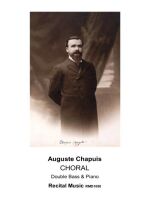Bass Duets Book 1

Double Bass Duet
Composer: Bottesini, Beethoven, David Heyes, James Hook, Vojta Kuchynka, Telemann, Offenbach, Frantisek Cerny, De Fesch, Gounod
Product code:
RMD1427
Publisher: Recital Music
£10.00
Description
Bass Duets Book 1 features ten inventive and accessible concert duets for the intermediate-advanced duo – five original works and five transcriptions. A wealth of styles and idioms include music from the 17th-century to the present day, encompassing music which is both player and audience friendly, exploring the entire range of the double bass.
Ideal as concert repertoire, sight-reading practice, or just to play with a friend.
The edition includes a score and two solo parts.
1. Giovanni Bottesini was the great double bassist of the 19th-century and composed three Gran Duetti for 2 double basses during his studies at the Milan Conservatoire. No.3 is in two contrasting movements and the opening Andantino demonstrates the lyrical and operatic qualities of the double bass, alongside a vibrant and engaging arpeggio accompaniment.
2. Beethoven’s Duo for 2 Flutes was composed on 23 August 1792, probably in Bonn before he moved to Vienna, and the Minuet & Trio is the second and final movement. Typical of the late Classical style, the music is elegant and stylish with interest for each player and transcribes well for double bass duet.
3. Originally a 3rd lower, The Night Watch was composed to be played by the composer and one of his younger students, and the title was influenced by Rembrandt’s painting of the same name. The melodic interest is primarily given to bass 1 (student), with a higher
accompaniment for bass 2 (teacher). The music is lyrical and sonorous, exploring the rich middle register of the double bass.
4. James Hook is mostly forgotten today but was a successful London opera composer and organist in his day. His Six Duetts for 2 Cellos Op.58 are charming and elegant, each
consisting of two or three movements, and are typical of music composed for amateur musicians and to be performed at home or at musical soirees. Duetto II has two movements, transposed an octave higher and sounding at the original cello pitch, with musical and technical challenges for each player.
5. Vojta Kuchynka studied composition at Prague Conservatoire with Antonín Dvořák and
was one of the leading Czech double bass soloists of his day. He composed a wealth of
virtuosic music for the double bass, many are now published by Recital Music, and Czech National Songs brings together a number of folk songs in a single movement work of great character and invention. The music is lyrical, exciting, dramatic and engaging with a powerful and pronounced coda which is played entirely in double stops.
6. Telemann’s Suite ‘Gulliver’s Travels’ for 2 violins was composed in 1728, quickly
becoming an instant hit and was one of the most inventive violin duos of the
Baroque age. Its five short movements are descriptive and ingenious and Intrada,
the opening movement, is grand and stately, portraying the excitement and agitation
as Gulliver begins his wonderful journey. Arranged for double bass duet in 2014 by
David Heyes, this is a colourful and exciting Baroque suite brimming with
excitement, drama, spirit and character.
7. Offenbach is remembered for almost 100 operettas written between 1850-70,
many still popular today, but he was also a noted cellist and composed a wealth of
music for the instrument. His Duos for 2 cellos (Op.49-54) range from very easy to
very difficult and Op.49, No.4 (very easy) has been transposed an octave higher in
this new edition for double bass duo. The two contrasting movements are lively and
attractive, with solo opportunities for each player and are written primarily in the
middle register with some thumb position work.
8. František Černý was Principal Bass of the National Theatre Orchestra in Prague
for many years and also taught at Prague Conservatoire. He composed a number of
works for double bass, emphasising the lyrical and virtuosic potential of the
instrument, and his Method for Double Bass, long out of print, features a number of
lyrical and appealing duets in bass clef. This duet, originally for half, first and
second positions, has been transposed an octave higher creating both musical and
technical challenges for the more advanced bass duo.
9. Willem de Fesch was a Dutch violone player and composer. He performed with
Handel in London in 1746, alongside concerts at Marylebone Gardens, a London
Pleasure Garden, in subsequent years. His compositional output is primarily
instrumental and his Op.9 Sonatas for violins or flutes were first published in
London in 1739. Sonata No.1 has three contrasting movements, with effective
interplay between the instruments, and would have been popular with amateur
musicians of the day.
10. Gounod’s Petite Etude-Scherzo is dedicated to V.F. Verrimst (1825-1893) and
was composed in Paris in 1885 and first published by Lemoine et Fils two years
later. Probably composed as a sight-reading exercise for double bass students at
the Paris Conservatoire, this edition has been transposed a fourth higher than the
original, creating exciting new challenges in the middle register of the instrument.
The music is engaging and appealing, with a strong rhythmic momentum
throughout, and abounds with good humour and enjoyment.
Description
Bass Duets Book 1 features ten inventive and accessible concert duets for the intermediate-advanced duo – five original works and five transcriptions. A wealth of styles and idioms include music from the 17th-century to the present day, encompassing music which is both player and audience friendly, exploring the entire range of the double bass.
Ideal as concert repertoire, sight-reading practice, or just to play with a friend.
The edition includes a score and two solo parts.
1. Giovanni Bottesini was the great double bassist of the 19th-century and composed three Gran Duetti for 2 double basses during his studies at the Milan Conservatoire. No.3 is in two contrasting movements and the opening Andantino demonstrates the lyrical and operatic qualities of the double bass, alongside a vibrant and engaging arpeggio accompaniment.
2. Beethoven’s Duo for 2 Flutes was composed on 23 August 1792, probably in Bonn before he moved to Vienna, and the Minuet & Trio is the second and final movement. Typical of the late Classical style, the music is elegant and stylish with interest for each player and transcribes well for double bass duet.
3. Originally a 3rd lower, The Night Watch was composed to be played by the composer and one of his younger students, and the title was influenced by Rembrandt’s painting of the same name. The melodic interest is primarily given to bass 1 (student), with a higher
accompaniment for bass 2 (teacher). The music is lyrical and sonorous, exploring the rich middle register of the double bass.
4. James Hook is mostly forgotten today but was a successful London opera composer and organist in his day. His Six Duetts for 2 Cellos Op.58 are charming and elegant, each
consisting of two or three movements, and are typical of music composed for amateur musicians and to be performed at home or at musical soirees. Duetto II has two movements, transposed an octave higher and sounding at the original cello pitch, with musical and technical challenges for each player.
5. Vojta Kuchynka studied composition at Prague Conservatoire with Antonín Dvořák and
was one of the leading Czech double bass soloists of his day. He composed a wealth of
virtuosic music for the double bass, many are now published by Recital Music, and Czech National Songs brings together a number of folk songs in a single movement work of great character and invention. The music is lyrical, exciting, dramatic and engaging with a powerful and pronounced coda which is played entirely in double stops.
6. Telemann’s Suite ‘Gulliver’s Travels’ for 2 violins was composed in 1728, quickly
becoming an instant hit and was one of the most inventive violin duos of the
Baroque age. Its five short movements are descriptive and ingenious and Intrada,
the opening movement, is grand and stately, portraying the excitement and agitation
as Gulliver begins his wonderful journey. Arranged for double bass duet in 2014 by
David Heyes, this is a colourful and exciting Baroque suite brimming with
excitement, drama, spirit and character.
7. Offenbach is remembered for almost 100 operettas written between 1850-70,
many still popular today, but he was also a noted cellist and composed a wealth of
music for the instrument. His Duos for 2 cellos (Op.49-54) range from very easy to
very difficult and Op.49, No.4 (very easy) has been transposed an octave higher in
this new edition for double bass duo. The two contrasting movements are lively and
attractive, with solo opportunities for each player and are written primarily in the
middle register with some thumb position work.
8. František Černý was Principal Bass of the National Theatre Orchestra in Prague
for many years and also taught at Prague Conservatoire. He composed a number of
works for double bass, emphasising the lyrical and virtuosic potential of the
instrument, and his Method for Double Bass, long out of print, features a number of
lyrical and appealing duets in bass clef. This duet, originally for half, first and
second positions, has been transposed an octave higher creating both musical and
technical challenges for the more advanced bass duo.
9. Willem de Fesch was a Dutch violone player and composer. He performed with
Handel in London in 1746, alongside concerts at Marylebone Gardens, a London
Pleasure Garden, in subsequent years. His compositional output is primarily
instrumental and his Op.9 Sonatas for violins or flutes were first published in
London in 1739. Sonata No.1 has three contrasting movements, with effective
interplay between the instruments, and would have been popular with amateur
musicians of the day.
10. Gounod’s Petite Etude-Scherzo is dedicated to V.F. Verrimst (1825-1893) and
was composed in Paris in 1885 and first published by Lemoine et Fils two years
later. Probably composed as a sight-reading exercise for double bass students at
the Paris Conservatoire, this edition has been transposed a fourth higher than the
original, creating exciting new challenges in the middle register of the instrument.
The music is engaging and appealing, with a strong rhythmic momentum
throughout, and abounds with good humour and enjoyment.



